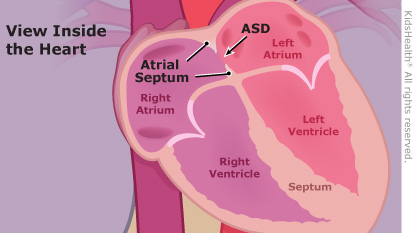Your child has a heart defect called an ASD (atrial septal defect). The heart has four chambers. The upper chambers are the right atrium and left atrium. They're divided by a wall of tissue called the atrial septum. An ASD is a hole in this wall that lets blood move from the left atrium into the right atrium, causing extra blood to go to the lungs. If the hole is large, the blood flowing through the hole makes an extra noise, known as a heart murmur. Health care providers can hear a heart murmur when listening to the heart with a stethoscope.
An ASD can be diagnosed at any age, but usually is found in babies or young kids.


In infants:
In older children:


You notice that:

How is an ASD diagnosed? To see if the heart murmur is caused by an ASD, a health care provider will do a test called an echocardiogram, or "echo." This painless ultrasound test takes pictures of the heart.
Sometimes children with an ASD may need a heart catheterization. During a catheterization, a thin, soft plastic tube (a catheter) is put into a blood vessel in the arm or leg, then threaded to the heart. The catheter takes measurements and pictures to help the cardiologist better understand what's going on in the heart. While the catheter is in the heart, the doctor may be able to patch the ASD by using a small device attached to the catheter.
What happens if the ASD can't be closed during the catheterization? If the ASD can't be closed during catheterization, surgery will be needed to close the hole. The health care team will decide when to do the surgery, depending on the size of the hole and how well your child's heart is working.